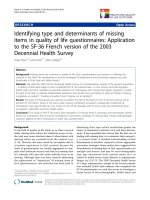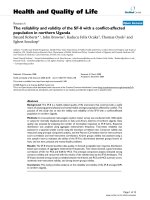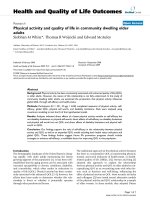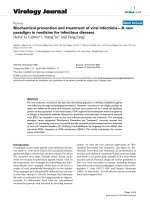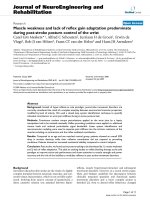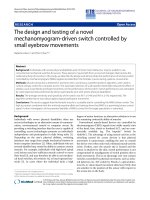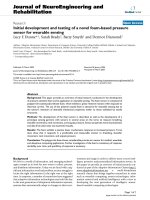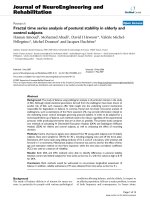Báo cáo hóa học: "Evaluation, diagnosis, and treatment of lead poisoning in a patient with occupational lead exposure: a case presentation" pptx
Bạn đang xem bản rút gọn của tài liệu. Xem và tải ngay bản đầy đủ của tài liệu tại đây (200.96 KB, 4 trang )
BioMed Central
Page 1 of 4
(page number not for citation purposes)
Journal of Occupational Medicine
and Toxicology
Open Access
Case report
Evaluation, diagnosis, and treatment of lead poisoning in a patient
with occupational lead exposure: a case presentation
D'souza Sunil Herman*
†1
, Menezes Geraldine
†2
and Thuppil Venkatesh
2
Address:
1
Department of Biotechnology, MLSC, Kasturba Medical College, Manipal University, Manipal, Karnataka, India and
2
National Referral
Center for Lead Poisoning in India (NRCLPI), Department of Biochemistry, St. John's Medical College, Bangalore, Karnataka, India
Email: D'souza Sunil Herman* - ; Menezes Geraldine - ;
Thuppil Venkatesh -
* Corresponding author †Equal contributors
Abstract
Amongst toxic heavy metals, lead ranks as one of the most serious environmental poisons all over
the world. Exposure to lead in the home and the workplace results in health hazards to many adults
and children causing economic damage, which is due to the lack of awareness of the ill effects of
lead. We report the case of a 22 year old man working in an unorganized lead acid battery
manufacturing unit, complaining about a longer history of general body ache, lethargy, fatigue,
shoulder joint pain, shaking of hands and wrist drop. Patient had blue line at gingivodental junction.
Central nervous system (CNS) examination showed having grade 0 power of extensors of right
wrist & fingers. Reflexes: Supinator- absent, Triceps- weak and other deep tendon reflexes- normal.
Investigations carried out during the admission showed hemoglobin levels of 8.3 g/dl and blood lead
level of 128.3 µg/dl. The patient was subjected to chelation therapy, which was accompanied by
aggressive environmental intervention and was advised not to return to the same environmental
exposure situation. After repeated course of chelation therapy he has shown the signs of
improvement and is on follow up presently.
Background
Lead is a ubiquitous and versatile metal which has been
used by mankind for many years. It ranks as one of the
most serious environmental poisons amongst the toxic
heavy metals all over the world. Mankind has used it for
many years because of its wide variety of applications.
Human exposure to lead is from numerous sources and a
myriad of pathways including air, food, dust, soil and
water. The common sources of lead exposure are use of
certain products containing lead such as lead soldered
cans, traditional practices such as folk remedies, cosmet-
ics, artisan ceramics, environmental emissions containing
lead and very importantly through occupations such as
production, use and recycling of lead, lead smelting, refin-
ing, alloying and casting, lead acid battery manufacture
and breaking, printing, jewellery making [1-5]. Many
workers who are working in the lead based industries are
ignorant of the ill effects of lead hence do not take proper
precaution while handling it, leading to higher level of
exposure. This case report emphasizes the management a
of lead poisoning case. The following sections provide an
overview of the evaluation, diagnosis and treatment.
Case presentation
We present a case of twenty-two-year old male admitted to
our hospital with the complaints of pain in the upper
abdomen, decreased sleep and appetite, general body
ache, tiredness, shoulder joint pain, shaking of hands, and
Published: 24 August 2007
Journal of Occupational Medicine and Toxicology 2007, 2:7 doi:10.1186/1745-6673-2-7
Received: 26 July 2006
Accepted: 24 August 2007
This article is available from: />© 2007 Herman et al; licensee BioMed Central Ltd.
This is an Open Access article distributed under the terms of the Creative Commons Attribution License ( />),
which permits unrestricted use, distribution, and reproduction in any medium, provided the original work is properly cited.
Journal of Occupational Medicine and Toxicology 2007, 2:7 />Page 2 of 4
(page number not for citation purposes)
wrist drop. On examination he was noted to have basal
metabolic index (BMI): 17.2, Pallor: ++, Coarse tremor:
++, BP: 160/100, Pulse: 78/mt, Blue line at gingivodental
junction, grade 0 power of extensors of right wrist & fin-
gers; Intrinsic hand muscles- normal, Other limbs- nor-
mal power. Reflexes: Supinator- absent, Triceps- weak,
Other deep tendon reflexes- normal, Superficial reflexes-
normal, Involuntary movement- tremor, Sensory, Cere-
bellar, Skull & Spine- normal.
Relevant history revealed that he had been working in an
unorganized lead based manufacturing unit since 6 years.
He claimed to be ignorant of the ill effects of lead and
used to work without taking any precautions.
Investigations carried out during the admission in our
hospital showed the following results:
Hemoglobin(Hb): 8.3 g/dl(14–16 g/dl); Total count(TC):
6100 C/cu m (4000–10,000 C/cu m); Differential
count(DC): Neutrophils 77% (40–78%), Lymphocytes
21% (20–45%), Monocytes 2% (2–10%); Erythrocyte
sedimentation rate (ESR): 8 mm/hr (0–9 mm/hr); Mean
corpuscular volume (MSV): 82 fl (76–96 fl); Platelet
count: 3.1 lac/cu mm(1.5–4.0 lac/cu mm); Peripheral
Smear: Normocytic hypochromic with no basophilic stip-
pling; Blood urea: 42 mg/dl (15–45 mg/dl); Serum creat-
inine: 0.98 mg/dl (0.6–1.2 mg/dl); Random blood sugar:
103 mg/dl (upto 140 mg/dl); Serum Electrolytes: Sodium
136 mEq/L (135–145 mEq/L), Potassium 4.3 mEq/L
(3.8–5.5 mEq/L), Chloride 101 mEq/L (95–105 mEq/L);
Test for rheumatoid arthritis and anti nuclear antibody
(ANA) negative thyroid function test: normal; Zinc pro-
toporphyrin(ZPP): 148 µg/dl(upto 40 µg/dl) ; Blood lead
level(BLL): 128.3 µg/dl (acceptable range 10 µg/dl); Other
heavy metal screening: below detectable limit.
In the present study, the blue line at the gums prompted
measurement of blood lead levels, which was markedly
elevated. The patient had low hemoglobin and high ZPP
levels indicating the lead induced adverse effects on
hematopoitic system. The symptoms like lethargy, fatigue,
peripheral neuropathy and weakness of forearm extensor
muscles indicate the effects on the nervous system. Studies
have shown that lead inhibits the enzymes δ-aminole-
vulinic acid dehydratase (ALAD) and ferrochelatse of the
heme synthetic pathway thus preventing conversion of
ALA to porphobilinogen and inhibits incorporation of
iron into the protoporphyrin ring respectively. This results
in reduced heme synthesis and elevated levels of the pre-
cursor δ-aminolevulinic acid (ALA), which is a weak
gamma-aminobutyric acid (GABA) agonist that decreases
GABA release by presynaptic inhibition [6,7]. Lead is
known to compete with metals like calcium, zinc, iron
and that are essential to our body. Lead's ability to substi-
tute for calcium is a factor common to many of its toxic
actions. Picomolar concentrations of lead, competes with
micromolar concentration of calcium for binding sites on
cerebellar phosphokinase C, thereby affecting neuronal
signaling [8]. Lead intoxication can affect any part of the
central nervous system or peripheral nervous system
depending on the level and duration of exposure. Lead
enters astroglia and neurons via voltage-sensitive calcium
channels [9]. Lead also attacks the peripheral nervous sys-
tem, which controls the muscle and organs outside the
brain. In addition lead causes a decrease in muscle
strength and eventually at high doses paralysis sets in. This
affects the radial nerve in particular, causing wrist drop.
The patient reported in the present study had elevated
blood pressure, despite any family history. Several lines of
evidence point to the association of blood lead levels with
increase in the blood pressure [10].
The detailed clinical investigation in the present study
helped us to diagnose the patient having lead toxicity.
Lead poisoning continues to be an environmental and
public health hazard of global proportions around the
world. Exposure to excessive levels of lead in the home
and the workplace impose immense costs, affecting adults
and children suffering from adverse health effects and
impaired intellectual development. Studies have found
that the highest levels of environmental contamination
were associated with uncontrolled recycling operations
and that the most highly exposed adults are those who
work with lead [11].
In the present study, the patient was unaware of the ill
effects of lead and was handling lead without taking any
precautions; he worked without the use of personal pro-
tective equipments like mask, gloves and safety glasses
even though they were provided. He ate and smoked in
the working place, which was having poor housekeeping
practices and minimum engineering control, lacking local
and general exhaust ventilation and washing facilities cul-
minating into alarmingly high blood lead levels of 128.3
µg/dl. According to United States Occupational safety and
Health Administration (OSHA) regulation (29 CFR
1910.1025 App B), workers with single BLL of 60 µg/dl or
greater or an average of the last three BLLs or all BLLs over
the previous six months at or above 50 µg/dl must be
removed from his or her regular job to a place of signifi-
cantly lower exposure.
The patient was advised to stop his lead related occupa-
tion and was subjected to repeated course of chelation
therapy using the chelator, D-penicillamine (3-mercapto-
D-valine), 25–35 mg/kg body weight/day in divided
doses for 3 weeks. Chelation therapy is administered in
order to increase the rate of excretion of lead in the short
term, by 25 to 30 times the normal, which may otherwise
Journal of Occupational Medicine and Toxicology 2007, 2:7 />Page 3 of 4
(page number not for citation purposes)
take months to years. Chelating agents competitively bind
lead, removing it from biologically active molecules, and
the complexes formed are excreted from the body. The
administration of the chelation to the patient in the
present study was accompanied by aggressive environ-
mental intervention, and the patient was not allowed to
return to the same environmental exposure situation.
There are many such unorganized battery manufacturing
units operating, where the younger generation have
exposed to this toxic heavy metal for many years and lead
gets deposited in soft tissues and bones of these individu-
als making these organs endogenous sources of lead for
many years even after these individuals are removed from
the ongoing exposure. In the present case the patient was
subjected to three courses of chelation therapy with 7 days
of gap between the each course. The BLL measured imme-
diately after the each course has shown a decline in the
levels. The cessation of chelation therapy for 30 days has
increased his BLL. Table 1. This patient was subjected to
4
th
course chelation therapy 32 days after the 3
rd
course.
After repeated course of chelation therapy, he showed
some signs of improvement. He responded with an
improvement in Hb to 13.2 g/dl. This was accompanied
by significant improvement in wrist drop, shaking of
hands and tiredness.
Though the chelation therapy, removes lead from the
blood and soft tissues, upon discontinuation of treat-
ment, it is redistributed from the bony compartment to
the blood [12]. This clearly suggests that the chronic lead
exposure requires repeated courses of treatment. The
patients undergoing chelation therapy require intensive
monitoring through out the treatment period and blood
lead levels should be estimated at the end of each course
and the subsequent therapy should be based on this deter-
mination.
Conclusion
Detailed clinical investigation is of prime importance for
identifying lead poisoning cases and while treating the
lead poisoning cases the chelation therapy must be
accompanied by aggressive environmental intervention.
The potential health hazards of lead poisoning still exist
and are rising due to the lack of education regarding the
dangers of working with lead. In a developing country like
India where over 80% of used lead is recycled by unorgan-
ized sector, who do not comply with any of the govern-
ment specified regulations. Some of these are as small as
a family owned smelting industry. These are neither regis-
tered nor visited by any regulating authorities. The lack of
a safe workplace and limited awareness among workers in
these unorganized industries has resulted in high blood
lead levels. Workers in these industries were observed to
have poor personal hygiene during and after work; they
were observed in the dining area wearing work clothes
and observed working without wearing proper respiratory
protection, gloves and mask. The employer had failed in
providing proper facilities for the workers. There were no
proper storage facilities for street clothes and no separate
areas were provided for the removal and storage of the
lead-contaminated protective work clothing and equip-
ment.
The regulatory body should make it mandatory to evalu-
ate and create awareness in the worker about the ill effects
of lead and should insist on regular health check up to
prevent adverse health effects. This preventable environ-
mental health hazard can be tackled only through proper
awareness and education and by implementing national
and international policies.
References
1. Smitherman J, Harber P: A case of mistaken identity: herbal
medicine as a cause of lead toxicity. Am J Ind Med 1991,
20:795-8.
2. Conroy LM, Lindsay RMM, Sullivan PM, Cali S, Forst L: Lead, Chro-
mium, and Cadmium exposure during abrasive blasting. Arch
Environ Health 1996, 51:95-9.
3. Dioka CE, Orisakwe OE, Adeniyi FAA, Meludu SC: Liver and renal
function tests in artisans occupationally exposed to lead in
mechanic village in Nnewi, Nigeria. Int J Environ Res Pub Health
2002, 1:21-5.
4. Menezes G, D'souza HS, Venkatesh T: Chronic lead poisoning in
an adult battery worker. Occup Med 2003, 53:476-478.
5. James MG, Gulson BL: Engine reconditioning workshop: lead
contamination and the potential risk for workers: a pilot
study. Occup Environ Med 1999, 56:429-431.
6. Warren MJ, Cooper JB, Wood SP, Shoolingin-Jordan PM: Lead poi-
soning, haem synthesis and 5-aminolevulinic acid dehy-
dratase. Trends in Biochemical sciences 1998, 23:217-221.
7. Roh Y-H, Kim K, Kim H: Zinc protoporphyrin IX concentra-
tions between normal adults and the lead-exposed workers
measured by HPLC, spectrofluorometer, and hematofluor-
ometer. Ind Health 2000, 38:372-79.
8. Markovac J, Goldstein GW: Picomolar concentrations of lead
stimulate brain protein kinase C. Nature 1988, 334:71-73.
9. Cheong JH, Bannon D, Olivi L, Kim Y, Bressler J: Differentmecha-
nisms mediate uptake of lead in a rat astroglial cell line. Tox-
icological sciences 2004, 77:334-340.
Table 1: Blood lead (BPb) and ZPP levels before and during the chelation therapy
Before Chelation After 1st
course of
chelation
After 2nd
course of
chelation
After 3rd
course of
chelation
30 days after
discontinuing
chelation
After 4th
course of
chelation
ZPP (µg/dl) 148 76 75 50 68 58
BPb (µg/dl) 128.3 60.9 51.5 40.1 95.5 60.3
Publish with BioMed Central and every
scientist can read your work free of charge
"BioMed Central will be the most significant development for
disseminating the results of biomedical research in our lifetime."
Sir Paul Nurse, Cancer Research UK
Your research papers will be:
available free of charge to the entire biomedical community
peer reviewed and published immediately upon acceptance
cited in PubMed and archived on PubMed Central
yours — you keep the copyright
Submit your manuscript here:
/>BioMedcentral
Journal of Occupational Medicine and Toxicology 2007, 2:7 />Page 4 of 4
(page number not for citation purposes)
10. Cheng Y, Schwartz J, Sparrow D, Aro A, Weiss ST, Hu H: Bone lead
and blood lead levels in relation to baseline blood pressure
and the prospective development of hypertension. The nor-
mative aging study. Am J Epidemiol 2001, 153:164-71.
11. Suplido ML, Ong CN: Lead exposure among small-scale battery
recyclers, automobile radiator mechanics, and their children
in Manila, the Philippines. Environ Res 2000, 82:321-8.
12. Schutz A: Chelatable lead versus lead in human trabecular
bone and compact bone. Sci Tot Environ 1987, 61:201-9.


